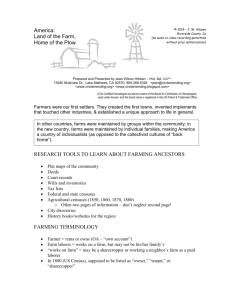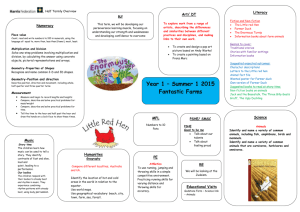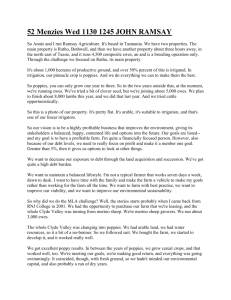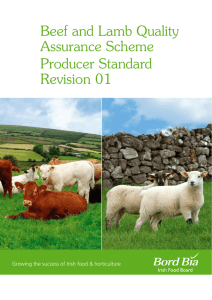Farming brieifing
advertisement
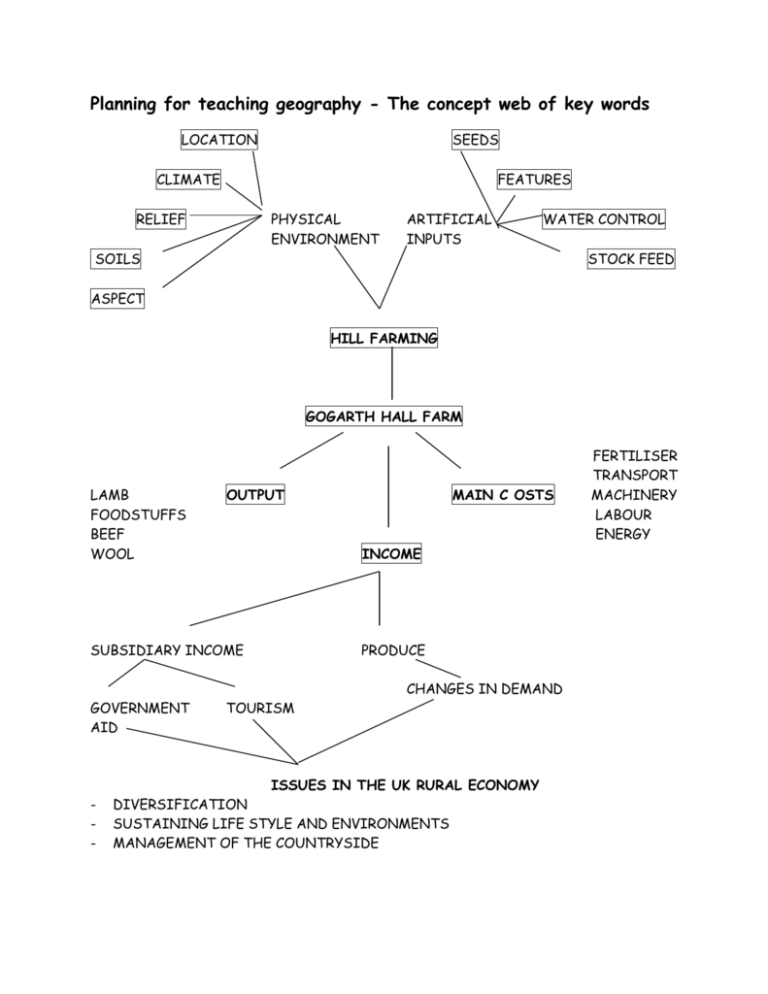
Planning for teaching geography - The concept web of key words LOCATION SEEDS CLIMATE FEATURES RELIEF PHYSICAL ENVIRONMENT ARTIFICIAL INPUTS WATER CONTROL SOILS STOCK FEED ASPECT HILL FARMING GOGARTH HALL FARM LAMB FOODSTUFFS BEEF WOOL OUTPUT INCOME SUBSIDIARY INCOME GOVERNMENT AID MAIN C OSTS PRODUCE TOURISM CHANGES IN DEMAND ISSUES IN THE UK RURAL ECONOMY - DIVERSIFICATION SUSTAINING LIFE STYLE AND ENVIRONMENTS MANAGEMENT OF THE COUNTRYSIDE FERTILISER TRANSPORT MACHINERY LABOUR ENERGY RURAL DIVERSIFICATION A briefing for colleagues Issues Problems facing British farmers – EU regulations, milk quotas, egg crisis, beef scare, CJD/mad cow disease, lamb prices, changing fashions in meat eating, competition from countries which subsidise farmers more than UK. e.g. from PRESS CUTTINGS Key questions How to understand the farmer’s predicament? What can the farmer do about it? Key objectives - gain a sense of place of what a hill farm is, looks like and understand how a hill farmer makes his money - appreciate the problems facing hill farmers today - consider diversification as a means of surviving in farming - (underlying concept of planning and managing environments towards sustainable development) Methods Key questions and key words SLIDES Case-study of Gogarth Hall Farm in mid-Wales. - Worksheet to complete after watching Update on monetary issues - sale of fleece 28p less per sheep = £300 on flock - sale of lamb for meat ROLE PLAY BUDGET EXERCISE – at slide 26 on fleece/mg. and lambcarcass. - Examples of diversification - on farm - ideas of 8/6 - ideas from the floor – what would you do with the old barn? Summary re-visit key issues/questions – see key cards HILL FARM: CASE STUDY. Name of farm: Gogarth Hall Farm. Name of farmer: Mr Ron Breese. Other workers: Mrs Deilwyn Breese, John and Arwyn. Location: Near Pennal on A493 between Machynlleth and Aberdovey; SSW of Cadair Idris. Size of farm: 360acres. PHYSICAL ENVIRONMENT. Weather: Cool Temperate Western Margin; mild in winter due to coastal location, rain all year. Relief: Occupies hill-top moorland, steep valley sides and very flat valley floor on Dovey tidal estuary. Valley at sea-level, A-road at 3m, hill-tops over 200m. Soils: Thin and rocky; evidence of acidity. Peat overlying clay in valley, silt and salt-marsh. Geology: Slate – heavily folded and distorted. Visible outcrops. INPUTS. Seeds: Grass. Fertilisers: Compounds – nitrogen, phosphate, potash. Water: 4 springs,1 brook, 2 bogs. Stock feed: Hay, straw, sugar beet, barley, molasses. OUTPUTS. Produce: Beef – 60 cattle; 20 yearlings, 20 cows, 20 calves. Sheep - 1200 ewes, 1400 lambs, 25 rams for lamb and wool. INCOME. Marketing of produce: Lamb £15/22 each Wool 16/23p. per fleece Beef £297 per cow. Government Aid: UK government grant £20 per ewe. EU government grant £20 per ewe. UK beef premium £60 per bull calf. Subsidiary income: Tourism – 2 self-catering cottages, 3 rooms B&B. EXPENDITURE. Rent/mortgage: nil. Transport: petrol and diesel. Machinery: 3 tractors, 1 livestock lorry, 1 pick-up, 2 cars. Labour supply: 4 full-time. Energy: electricity. Contract labour: 45p to shear each sheep. Fertiliser. Feedstuffs. ISSUES. Support for the rural economy. Diversification in hill farming. GOGARTH. Diversification – Forestry Commission - Self-catering; Coach-house,Farmhouse, caravan. - Bed and breakfast. - Cwm Ffernol. - Cefn Crib. - Own lamb sales. Other options: - Quad bike treks. - Farm trails. - Shooting grounds. - Caravans and camping. Considerations: Local butcher sells each lamb for £30/35. Local mill sells sheepskin rug for £35. Ewe Sales: 1996 = £36 1997 = £30 1998 = £8 1999 = £5. Cattle Sales: 1996 = £700 1998 = £300 1999 = £297.




